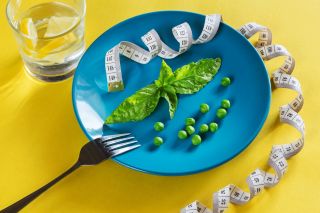Appetite
Can Uridine Improve Anorexia Treatment?
While early results are promising, a lot more research is needed.
Posted February 14, 2023 Reviewed by Ekua Hagan
Key points
- Uridine is a biological substance that regulates food consumption and feelings of hunger.
- While uridine has been shown to increase hunger and food consumption in healthy humans, its effects have not been tested in people with anorexia.
- Previous research suggests that uridine alone is unlikely to improve anorexia treatment; additional therapeutic approaches will be needed.
.jpg?itok=HiNFBNE9)
Eating disorders cause immense suffering and cost the US over $65 billion dollars a year.1 Despite this, we have yet to develop an effective biological treatment for anorexia nervosa (AN).2
Typical treatment options for AN include cognitive behavioral therapy (CBT) and medical stabilization (e.g., electrolyte rebalance). Most individuals with AN, however, do not initially respond to these treatments and require several treatment attempts to achieve full symptom remission.
Even more concerning: Many individuals with AN will never reach full symptom remission. As reported in a recent study, only 63 percent of the study's female participants fully recovered from AN (e.g., no observable symptoms) 22 years after finishing their treatment, with 18 participants dying during this period.3 These statistics mean that some individuals with AN will continue to experience AN symptoms throughout their life, making them vulnerable to AN relapse.
Finding an effective treatment for AN is important because the longer this disorder persists, the more resistant it becomes to treatment, and the more damage it does to the body and brain.
Increasing Hunger With Uridine
In the science world, uridine is best known as a biological substance used by the body to make ribonucleic acid, or RNA (a nucleic acid that builds the body's necessary proteins).
Uridine doesn't just make RNA, though. It also controls metabolism and food intake by stimulating certain brain cells (e.g., AgRP neurons) in the hypothalamus (e.g., the brain's appetite center) to make us hungry.4

To test if uridine truly plays a role in hunger and food consumption, Hanssen et al. (2023) measured uridine levels in the blood of 39 young adults before, during, and after they ate at a buffet. The researchers also measured participants' hunger ratings before and after the buffet, as well as how much food they ate.
Results revealed that participants with higher uridine levels in their blood also had higher hunger ratings and ate more food.5 Likewise, participants' blood uridine, hunger ratings, and food consumption levels dropped after they ate.
This study, however, doesn't verify that uridine caused the observed increase in participants' appetite and food consumption. It just shows that hunger and food consumption are related to uridine in some way.
To help determine if uridine caused the observed increases in participants' hunger and food consumption in this study, Hanssen et al. (2023) conducted a follow-up test. In this follow-up study, each participant was given a uridine substance mixed with orange juice. After drinking the uridine cocktail, participants had their hunger ratings, food consumption, and uridine blood levels measured before, during, and after eating at a buffet. For comparison, the same participants were given a placebo (e.g., orange juice without uridine) on a different day. After drinking the plain orange juice, participants again had their hunger ratings, food consumption, and uridine blood levels measured at a buffet.
The results from this follow-up study confirmed that uridine circulating in the blood contributes to increased hunger and food consumption.5 Participants who drank the uridine orange juice cocktail had increased blood uridine levels, hunger ratings, and food consumption compared to their scores on these measures when they drank plain orange juice.
This study helps verify that levels of uridine circulating in the blood can increase food consumption and hunger in healthy people.
Uridine: A New Treatment for Anorexia Nervosa?
But do these results mean that uridine can improve AN treatment? It's too early to tell. We first need to test whether uridine increases food consumption and hunger in people receiving treatment for AN. And that's not all. There are several additional factors that we need to consider when researching appetite in AN.

While groundbreaking, the Hanssen et al. (2023) study overlooks the complexity of appetite, which is a subjective and multifaceted concept. Appetite isn't regulated by one biological substance. Rather, it is dependent on a variety of factors, including food desirability, motivation to eat, sensory experiences (e.g., palatability), gastric health (e.g., gastric emptying), and interoceptive awareness (e.g., ability to recognize appetite cues).
People currently ill with and recovered from AN tend to experience heightened fullness and muted hunger cues.6 This suggests that people with AN have impaired appetite signaling. Why people with AN experience impaired appetite, however, is unknown. One explanation for this is that AN symptoms (e.g., chronic starvation and excessive exercise) change the way ghrelin (a hormone that increases hunger) does its job.10 In people with AN, ghrelin might be utilized by the brain to increase motor restlessness and alter the rewarding experiences of starvation as a way to adapt to chronic food restriction.
Appetite impairment doesn't fully explain food resistance in AN, though. Reduced desire to eat is another culprit. For example, when observing pictures of high-calorie foods, people ill with AN have low activation in reward and motivation brain regions (e.g., amygdala);7 some individuals with AN also experience muted taste while eating.8 Consequently, regardless of how hungry they are, people with AN might not be motivated to eat. Also of concern, people with AN have low activation in the insula, a brain region that helps us recognize appetite cues, after eating a meal.7 This means that people with AN might be unable to recognize when they are hungry or full.
We also have to consider the psychological aspects of eating motivation. Research has shown that people with AN fear the experience of feeling full.9 This fear of fullness might override feelings of hunger, making individuals with AN resistant to eating to avoid feeling satiated.
Conclusions
Substantial evidence exploring resistance to eating in AN suggests that uridine supplementation alone will not increase food consumption during AN treatment. The question remains whether uridine in combination with other treatment approaches (e.g., CBT) can help motivate those receiving treatment for AN to eat.
To better understand uridine's effects on hunger for those with AN, future research will need to explore what biological mechanisms uridine exploits to increase hunger. Likewise, the long-term safety and efficacy of uridine supplementation will need to be tested in people with AN.
References
1) Deloitte Access Economics. Social and economic cost of eating disorders in the United States of America: report for the Strategic Training Initiative for the Prevention of Eating Disorders and the Academy for Eating Disorders. Published June 2020. Accessed January 30, 2023. https://cdn1.sph.harvard.edu/wp-content/uploads/sites/1267/2020/07/Social-Economic-Cost-of-Eating-Disorders-in-US.pdf.
2) Kaye, W.H., & Bulik, C.M. (2021). Treatment of patients with anorexia nervosa in the US - a crisis in care. JAMA Psychiatry, 78, 591-592. doi:10.1001/jamapsychiatry.2020.4796.
3) Eddy, K.T., Tabri, N., Thomas, J.J., Murray, H.B., Keshaviah, A., Hashtings, E.,...& Franko, D.L. (2017). Recovery from anorexia nervosa and bulimia nervosa at 22-year follow-up. Journal of Clinical Psychiatry, 78, 184-189. doi: 10.4088/JCP.15m10393.
4) Steculorum, S.M., Paeger, L., Bremser, S., Evers, N., Hinze, Y., Idzko, M., Kloppenburg, P., and Bruning, J.C. (2015). Hypothalamic UDP increases in obesity and promotes feeding via P2Y6-dependent activation of AgRP neurons. Cell, 162, 1404–1417. https://doi.org/10.1016/j.cell.2015.08.032.
5) Hanssen, R., Rigoux, L., Albus, K., Kretschmer, A.C., Thanarajah, S.E., Chen, W.,...& Tittgemeyer, M. (2023). Circulating uridine dynamically and adaptively regulates food intake in humans. Cell Reports Medicine, 4. doi:https://doi.org/10.1016/j.xcrm.2022.100897.
6) Klastrup, C., Frølich, J., Winkler, L.A., & Støving, R.K. (2020). Hunger and satiety perception in patients with severe anorexia nervosa. Eating and Weight Disorders – Studies on Anorexia, Bulimia, and Obesity, 25, 1347-1355.
7) Holsen, L.M., Lawson, E.A., Blum, J., Ko, E., Makris, N., Fazeli, P.K.,...& Goldstein, J.M. (2012). Food motivation circuitry hypoactivation related to hedonic and nonhedonic aspects of hunger and satiety in women with active anorexia and weight-restored women with anorexia nervosa. Journal of Psychiatry and Neuroscience, 37, 322-332. doi: https://doi.org/10.1503/jpn.110156.
8) Kinnaird, E., Stewwart, C., & Tchanturia, K. (2018). Taste sensitivity in anorexia nervosa: A systematic review. International Journal of Eating Disorders, 51, 771-784.
9) Schaumberg, K., Reilly, E.E., Gorrell, S., Levinson, C.A., Farrell, N.R., Brown, T.A.,...& Anderson, L.M. (2021). Conceptualizing eating disorder psychopathology using an anxiety disorders framework: Evidence and implications for exposure-based clinical research. Clinical Psychology Review, 83. https://doi.org/10.1016/j.cpr.2020.101952.
10) Méquinion, M., Langlet, F., Zgheib, S., Dickson, S., Dehouck, B., Chauveau, C., & Viltart, O. (2013). Ghrelin: Central and peripheral implications in anorexia nervosa. Frontiers in Endocrinology, 4. https://doi.org/10.3389/fendo.2013.00015.




